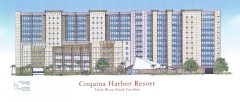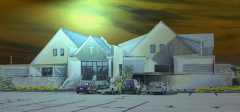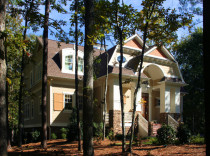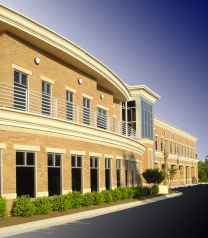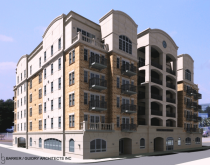Architectural Services
FULL AND COMPREHENSIVE SERVICES
1.1 QUALITY ASSURANCE
To insure quality throughout the entirety of a design project, several measures are taken: regular staff meetings to keep our personnel well informed, consistent contact with our clients, documentation, and careful record keeping.
Our efforts to maintain quality projects have been highly beneficial to our clients. We consistently keep bids within five percent of our final estimates. As a result of proper planning, a thorough design process and quality document preparation, change orders and design changes during construction are kept to a minimum. Because of our high quality standards, we have numerous clients who come back to us for future projects. Additionally, eighty percent of all our work is from referral clients. Our desire to maintain this level of service provides an assurance that quality work will continue for all future clients.
1.2 COMPUTER AIDED DESIGN- CAD
Guidry-Coastal Architecture Inc. values the use of new computer technology in its practice of Architecture. The use of computer-aided design (CAD) has maximized our ability to produce quality construction documents and improved our firm’s coordination of consultants.
1.3 THE ARCHITECT
The Architect is a professional whose training and experience have equipped him to guide you through the entire complex building process. He is a specialist who knows how to translate your thoughts of building into reality. Blending the ingredients of your requirements, the restrictions of building codes, budgets and site conditions, along with the Architect's creative abilities, he is able to design a building of beauty, quality, proportion and distinction.
Although Architecture involves esthetic expression as a foremost consideration, its practice has other important aspects: planning, technical guidance, and administration. The Architect is trained to design with consideration for health, safety, and efficient and economical operation, utilizing materials and equipment most appropriate for their particular application.
The profession of Architecture requires practitioners possessing integrity, sound business capability, and technical and artistic ability. As professional adviser to his client, the Architect must act objectively in his client's interest; however, during construction he is charged with the responsibility for impartial interpretation of the performance of both Owner and Contractor. In addition to direct legal responsibility to his profession.
Technological developments in the construction industry have produced new concepts in aesthetics and utility. New materials and new structural and mechanical systems, in combination with time-tested methods of construction, have made the practice of architecture more complex than ever. The Architect must be knowledgeable in many fields; creative design, construction, engineering, business administration, and he also must be familiar with construction law. Being at the center of the design- build process, the Architect's skill, training, and conceptual ability equip him to coordinate these components throughout the course of the project.
In order to safeguard the public health, safety, and welfare, every state, and the District of Columbia have enacted laws for the licensing of Architects. The minimum requirements for licensing usually include possession of a degree from an accredited five or six year school of architecture, completion of a minimum three year internship involving practical experience under the direction of a licensed Architect, and passing a formal, comprehensive professional examination. As in other professions, the Architect continues his education throughout his professional career.
1.4 SELECTION OF THE ARCHITECT
Selection of the Architect is one of the most important decisions an Owner makes when he undertakes a building program. He should select a professional on the basis of competence and integrity who will be both a designer and an adviser to translate his requirements into reality. An Architect may be retained by direct selection, comparative selection, or design competition. Regardless of the method of selection, the Architect should not be selected as a result of competition with other Architects on the basis of fee compensation only.
1.5 BASIC ARCHITECTURAL SERVICES
The Basic Services, as set forth in the AIA standard Form of Agreement Between Owner and Architect are outlined below.
THE SCHEMATIC DESIGN PHASE includes conferences with the Owner after which we study and analyze a building program. He should select a professional on the basis of competence, integrity, and ability to develop a design fulfilling project requirements. At this stage, schematic design studies consisting of drawings and other documents illustrating the scale and relationship of project components, including such considerations as structure, code requirements, and materials will be undertaken. Upon approval by the Owner of the Schematic Design documents, this phase of service is complete.
THE DESIGN DEVELOPMENT PHASE includes the preparation of more detailed drawings and other data relating to building appearance and structure, mechanical and electrical systems, construction materials and finishes, and other essentials. When the Owner approves these documents, this phase is complete.
THE CONSTRUCTION DOCUMENTS PHASE includes the preparation of the construction documents and specifications describing in technical detail the construction contract, work to be done, materials, equipment, workmanship, and finishes required for architectural, structural, mechanical and electrical work-and related site work, utility connections, and special equipment. We also assist the Owner in the preparation of information for bidders, proposed contract forms, and Conditions of the Contract covering responsibilities during construction. We also advise the Owner of probable construction cost.
During this phase, any changes from the approved design development documents are to be made only with the Owner's written approval, and changes in the estimated construction cost must be mutually understood. If the Owner orders any major revisions in the construction documents which are inconsistent with his previous approvals or instructions, we are entitled to additional compensation to effect the changes. When we have prepared the working drawings and specifications and have assembled the bidding documents, this phase is complete.
THE BIDDING OR NEGOTIATION PHASEincludes advising the Owner about the qualifications of prospective contractors, and assisting him in obtaining bids or negotiated proposals and in awarding construction contracts.
THE CONSTRUCTION PHASE-ADMINISTRATION OF THE CONSTRUCTION CONTRACT
generally includes:
-Preparation of supplementary drawings.
-Review of the Contractor's Schedule of Values (a detailed cost breakdown of categories of materials and building trades): review of fabricators' and suppliers' shop drawings, material samples and equipment, and other required submissions.
-General administration of the construction contract(s) including periodic visits to the site to review the progress and quality of work and to determine if work is proceeding in accordance with the contract documents.
-Review of the Contractor's applications for payment, determination of amounts owing to the Contractor, and issuance of certificates for payments in such amounts.
-Preparation of Change Orders covering authorized changes in the work.
-Determination of the date of substantial completion and final completion; receiving, reviewing, and forwarding to the Owner the specified written guarantees assembled by the Contractor, and issuance of the final certificate for payment. Our Basic Services are concluded when a final certificate for payment is issued to the Owner.
1.6 ADDITIONAL SERVICES
Certain projects may require services beyond the scope of Basic Services. These Additional Services may include:
-Financial feasibility or other special studies
-Planning surveys, site evaluations, or comparative studies of prospective sites
-Investigation of existing conditions or facilities
-Detailed Estimates of Construction Cost or detailed quantity surveys of inventories of material, equipment, and labor
-Interior design and other services required for the selection of furnishings
-Planning tenant or rental spaces
-Consultation concerning replacement of any work damaged by major defects in the work of the Contractor in the performance of the construction contract
-Preparation of reproducible record prints of drawings showing significant changes in the work made during construction
-Extensive assistance in utilization of equipment or systems such as initial start-up or testing, adjusting, and balancing, preparation of operating and maintenance, and consultation during operation
-Preparation of additional documentation in support of construction documents to building officials
-Providing services after issuance to the Owner of the final certificate for payment
-Expert testimony in connection with any public hearings, arbitration or legal proceeding,
In addition to normal professional services available for a construction project, an Architect may provide construction management services, consultation on general architectural matters including the conduct of architectural competitions and the selection of architects, industrial product design and special esthetic or technical.
1.7 OWNER AND ARCHITECTS RELATIONS DURING CONSTRUCTION
The Owner should clearly understand his responsibilities and those of the Architect during the course of the project. Throughout the project, the Architect is the Owner's professional adviser. During the design phases, the Architect serves as an objective, independent professional endeavoring to carry out the Owner's wishes. During construction, the Architect acts in a dual capacity. He continues to serve as the Owner's professional adviser and agent during the construction process, and he also serves as an impartial arbiter between the Owner and the Contractor in the interpretation of the contract documents and in resolving questions and disputes which arise between Owner and the Contractor. A full statement of the Architect's services during construction is found in the Owner-Architect agreements and the General Conditions of the Contract for Construction.
The Owner in his own interest should act promptly on all questions, submission, orders and certificates submitted by the Architect so that the project may proceed economically and in an orderly manner.
If the Owner is not in a position to follow the project closely, or is an institutional or corporate client, a representative should be designated to act on his behalf with respect to the project. An owner's representative can do much to improve communication with the Architect and to reduce the possibility of misunderstanding.
1.8 INFORMATION AND SERVICES FURNISHED BY THE OWNER
During the course of the project, the Owner must furnish certain information and services to the Architect. Legal, accounting and insurance advice for the project must come from the Owner's lawyer, accountant, and insurance adviser. The Owner must be prepared to furnish the services of a certified land surveyor and a soils engineer. Special tests may be required for the project and these are the Owner's direct responsibilities. The Architect can aid in the facilitation of these tests. However, final decisions and responsibility for the information and services lies with the Owner.
The Owner must inform the Architect about all functional and occupancy requirements to be considered in the design of the project. He must be completely candid with the Architect about financial limitations affecting the project; if there is a fixed limit of construction cost, the Owner must specifically notify the Architect and allow him to have reasonable latitude to adjust the quality and scope of the project to bring it within the available funds. Even so, the Architect cannot guarantee the price of bids or negotiated proposals which will be submitted by contractors.
If the Owner desires to make changes in the drawings after a definite scheme has been approved by him, or desires changes in the work after construction begins, the Architect shall be reimbursed for such additional work. Should the execution of any work designed or specified by the Architect, or any part of such work, be abandoned or suspended, the Architect is to be paid in accordance with or in proportion to the terms and payments set forth in the Owner-Architect Agreement, and up to the time of such abandonment or suspension.

